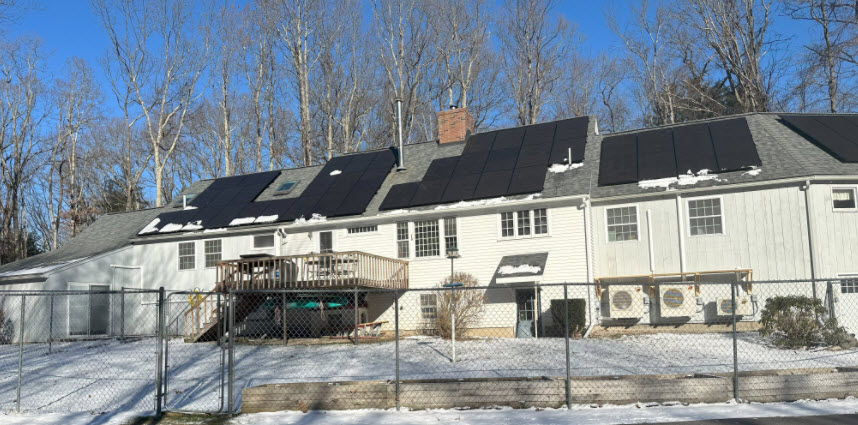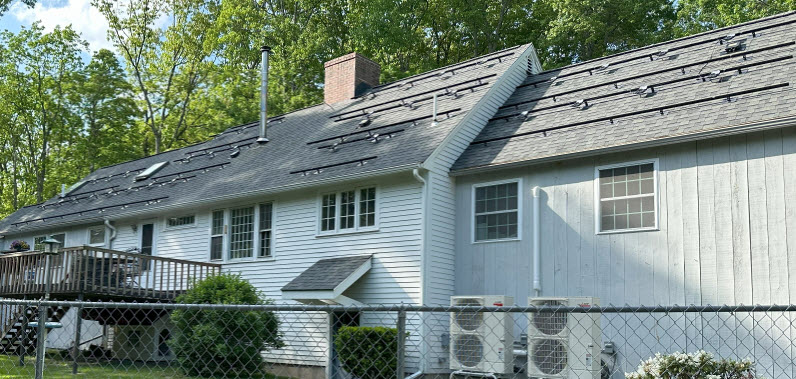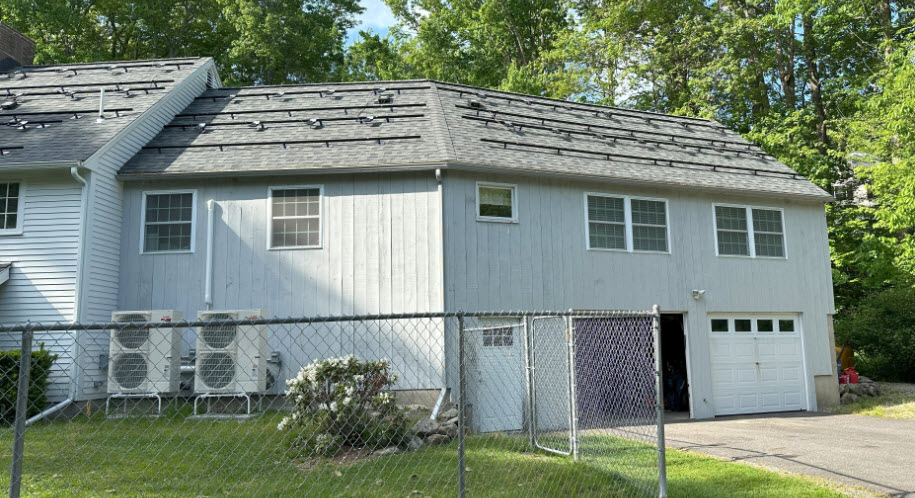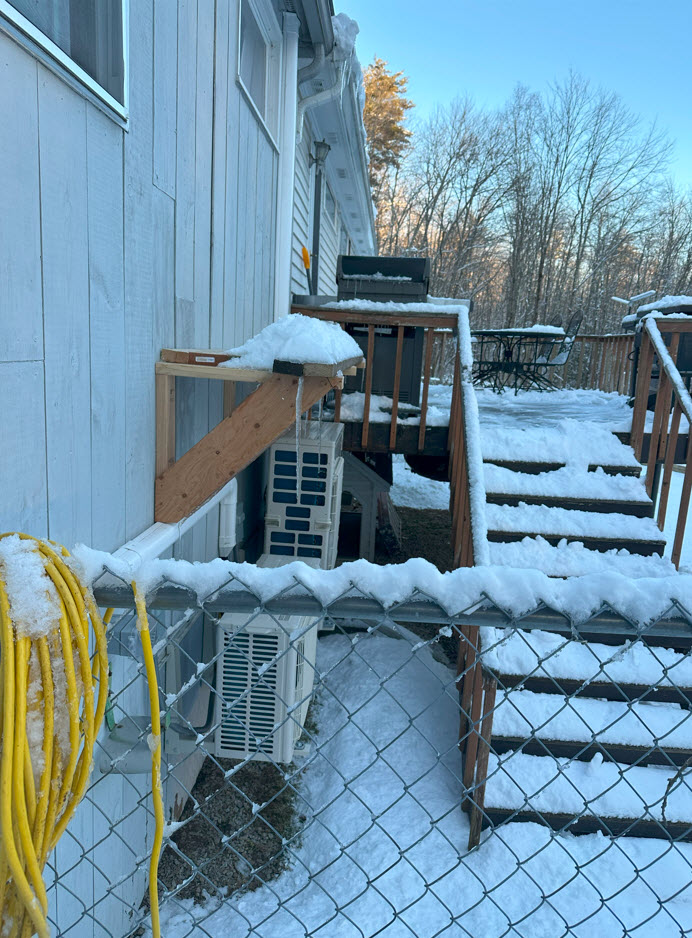PROJECT: 48-panel, 425kwh n-phase Solar Panels
YEAR: 2024
CONTRACTOR: 603 Solar
STAR RATING: FIVE STARS - FANTASTIC!!!
The second phase of our major energy efficiency project involved incorporating solar power. After experiencing a dramatic increase in electricity rates from Eversource in September 2022, we knew we needed a sustainable solution for more predictable monthly expenditures.

To put it into perspective, our electric bill skyrocketed from $349.33 in July 2022 to $661.21 in September 2022—despite consuming 400 KWH less energy. The residential electric supply charge doubled, jumping from 10.4 cents/KWH to 22.6 cents/KWH. Although the rate was later reduced to 20.2 cents/KWH in February 2024, this minor decrease did little to alleviate the financial burden imposed on homeowners.
We initially undertook an energy efficiency project that consisted of three phases:
- Installing mini-splits and heat pumps - for year-round heating and cooling
- Adding solar panels - to generate more energy than we consumed
- Installing a full-house generator - for backup power
Due to budget and time constraints, we completed only the first two phases. While the mini-split and heat pump project proved to be a MAJOR disappointment, our solar installation was a complete success.

To ensure a reliable and efficient solar installation, we sought bids from multiple contractors. Fortunately, we had a trusted friend who recommended 603 Solar. They weren’t the cheapest option, nor were they the most expensive, but their professionalism set them apart. Having already dealt with a frustrating experience with our mini-split installers, we needed a team that would deliver exceptional results—and 603 Solar did just that.
From start to finish, 603 Solar exceeded our expectations. Their communication was top-notch, their pricing was competitive, and their workmanship was outstanding. Unlike our previous experience with New England Mini Split Installers, this team was transparent, efficient, and reliable. Post-installation support has also been phenomenal, ensuring that our system continues to operate optimally.

We initially planned for a 40-panel system but ultimately upgraded to 48 panels. The reason? Our mini-splits and heat pumps consumed significantly more energy than we had anticipated. To compensate for their inefficiency, we needed additional solar capacity. The total cost of the project was around $60,000, which we financed in part. By investing in solar, we essentially locked in a fixed electric bill rather than remaining vulnerable to unpredictable utility rate hikes.
One of the major benefits of our system is its 25-year product warranty and 12-year workmanship warranty, ensuring long-term reliability. In New Hampshire, net metering allows homeowners to send excess solar energy back to the grid in exchange for credits.

These credits are then used to offset future energy costs. For instance, if we generate 200 KWH in a day and use only 120 KWH, we receive credits for the surplus at the current supply rate. While this balancing act requires strategic energy management, it ultimately helps us control costs more effectively.
Our home, a rambling cape with an ideal east-west orientation, provides excellent southern exposure for solar production. Even in Bedford, New Hampshire, we generate a substantial amount of electricity throughout the year.
Although production drops from December to February due to lower sun angles, the remaining nine months compensate for the seasonal dip. Our system's performance over its eight months since installation speaks for itself:
June 2024 – 1.9 MW produced / 1.4 MW consumed (268 KW credit) – $180 electric bill
July 2024 – 2.4 MW produced / 2.2 MW consumed (164 KW credit) – $60 electric bill
August 2024 – 2.0 MW produced / 1.9 MW consumed (21 KW credit) – no electric bill
September 2024 – 2.1 MW produced / 1.5 MW consumed (531 KW credit) – no electric bill
October 2024 – 2.3 MW produced / 1.7 MW consumed (594 KW credit) – no electric bill
November 2024 – 1.7 MW produced / 2.1 MW consumed (448 KW debit) – no electric bill
December 2024 – 1.3 MW produced / 2.7 MW consumed (1400 KW debit) – $12 electric bill
January 2025 – 1.5 MW produced / 1.3 MW consumed (183 KW credit) – $60 electric bill
Lessons Learned and Recommendations
While our solar investment has proven beneficial, we learned several valuable lessons along the way. First, it is crucial to accurately estimate energy consumption when integrating new systems like mini-splits and heat pumps.

These mini-split units were advertised as energy-efficient, but in reality, they consumed far more power than expected. Additionally, working with a reputable and experienced solar contractor is key to a smooth installation and long-term success. We highly recommend obtaining multiple quotes and seeking personal recommendations before committing to a provider.
Another tid-bit that we quickly learned in the winter-time was that we really shouldn't have had any of the condensers installed under the sloping roof. Snow and ice slide off the solar panels in fairly large batches / chunks. I think they would have crushed the condensers' aluminum caps pretty easily.
Luckily, I had built some temporary roofs over them prior to the snow flying, but I'll need to build more permanent ones in the Spring.

The Importance of Due Diligence
Conducting thorough research before making major home energy investments cannot be overstated. We assumed that mini-splits would significantly reduce our heating costs, but without detailed research and real-world data, we were left with higher expenses than anticipated. Homeowners should investigate case studies, customer reviews, and independent reports before choosing energy-efficient solutions. This applies to solar installations, heating and cooling systems, and other significant home upgrades.
Moving Forward
Looking ahead, we plan to optimize our energy efficiency strategy by refining our heating approach. Since mini-splits were not as effective as expected, we have reverted to using our oil-fired forced hot water system and wood stove during the winter months. Additionally, we will monitor our solar production closely to determine if battery storage is a viable addition to our system, reducing our reliance on net metering and providing greater energy independence.

Final Thoughts
Despite the setbacks with our mini-split heating system, we are incredibly satisfied with our solar investment. It has provided us with energy stability, cost savings, and a sustainable power source for years to come. If you’re considering going solar in New Hampshire, due diligence and choosing a trusted installer like 603 Solar will make all the difference. Solar energy is a long-term investment, and with the right approach, it can significantly improve your financial and environmental footprint.
If you do decide to go with 603 Solar, please tell them that Jon Luby sent you! They have a referral program, but as you'll see in all of our reviews, I only refer you to the contractors and suppliers that I personally trust.
If you have any questions, please don't hesitate to contact us!
